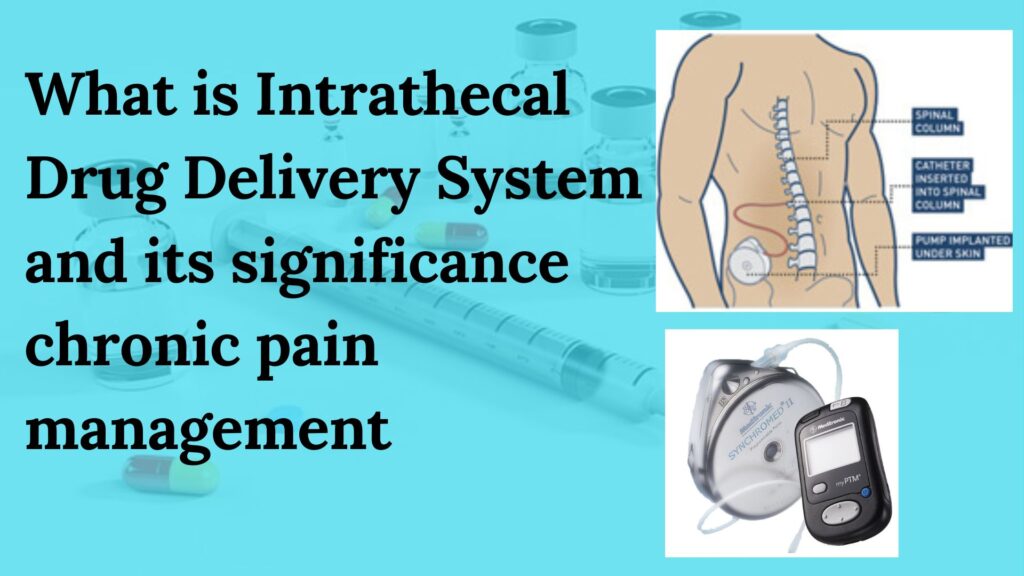WHAT IS INTERATHECAL DRUG DELIVERY SYSTEM AND IT’S SIGNIFICANCE CHRONIC PAIN MANAGEMENT

In the pursuit of more effective and targeted pain management, medical science has
unveiled the Intrathecal Drug Delivery System (IDDS). This innovative approach has redefined the way chronic pain is treated, offering a promising solution for individuals
seeking relief from persistent discomfort. In this short blog we can discuss what is Intrathecal Drug Delivery System and how it is transforming the landscape of pain management.
What is Intrathecal Drug Delivery:
The Intrathecal Drug Delivery System involves the direct delivery of medications into the
intrathecal space surrounding the spinal cord. Unlike traditional oral medications that may be associated with systemic side effects, this system utilises a surgically implanted pump and catheter to administer drugs precisely where they are needed most—near the spinal cord.
How It Works:
1.Implantation Process:
A small pump, usually placed under the skin of the abdomen, is connected to a catheter
that is carefully threaded into the intrathecal space. This implantation process is typically
performed by a skilled medical professional.
2.Controlled Medication Delivery:
The pump is programmed to deliver a controlled and continuous flow of medication directly
to the spinal cord. This targeted delivery ensures that the medication acts precisely where
pain signals are transmitted and processed.
Advantages of Intrathecal Drug Delivery System:
1.Targeted Pain Relief:
The primary advantage of the Intrathecal Drug Delivery System is its ability to provide
targeted pain relief by delivering medications directly to the spinal cord. This focused
approach enhances the efficacy of pain management.
2.Reduced Side Effects:
By delivering medications directly to the site of action, the Intrathecal Drug Delivery System minimises the risk of systemic side effects often associated with oral medications.
This is particularly beneficial for patients who may be sensitive to certain medications.
3.Customised Treatment Plans
Healthcare providers can adjust the type and dosage of medications to meet the specific
needs of individual patients.This customization allows for a more personalised and effective
pain management strategy.
4.Continuous Pain Control:
The system provides a continuous and controlled delivery of medication, ensuring a
consistent level of pain relief over an extended period. This is advantageous for individuals
with chronic pain conditions that require ongoing management.
5.Reduced Dependency on Oral Medications:
For patients who may have difficulty tolerating or responding to oral medications, the
Intrathecal Drug Delivery System offers an alternative route of administration, reducing
reliance on systemic medications.
Limitations of Intrathecal Drug Delivery System:
- Surgical Implantation:
The procedure to implant the pump and catheter system is invasive and carries inherent
risks associated with surgery. Complications may include infection, bleeding, or problems
related to the implanted devices. - Limited Medication Options:
Not all medications are suitable for intrathecal delivery. The options for medications that
can be used with this system may be limited, potentially restricting the choice of treatments
for some patients. Now the FDA approved medicines for IDDS are Morphine, Ziconotide and
Baclofen. - Cost and Accessibility:
The initial cost of implanting the Intrathecal Drug Delivery System, along with ongoing maintenance and monitoring, can be a significant financial consideration. Accessibility to this
advanced form of pain management may be limited based on healthcare infrastructure and resources.
Conclusion
The Intrathecal Drug Delivery System represents a remarkable leap forward in the realm of
pain management. Its targeted and controlled approach not only offers effective relief but
also minimises the side effects associated with systemic drug administration. As medical science continues to advance, the Intrathecal Drug Delivery System stands as a beacon of
hope for those navigating the challenges of chronic pain, promising a brighter and more
comfortable future.
✍Ubaidulla K M
MPharm
Pharmacy Blogger
Website: https://www.itsmepharmacist.com🌐




